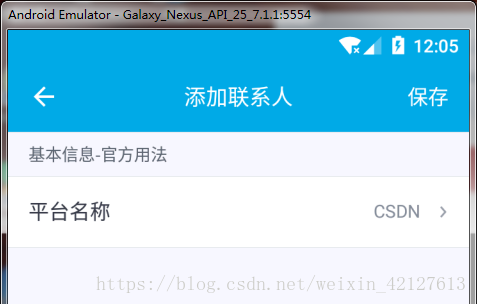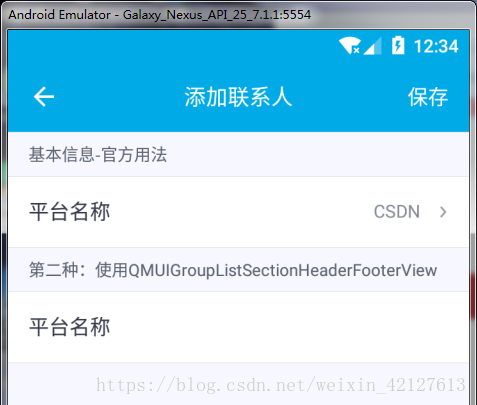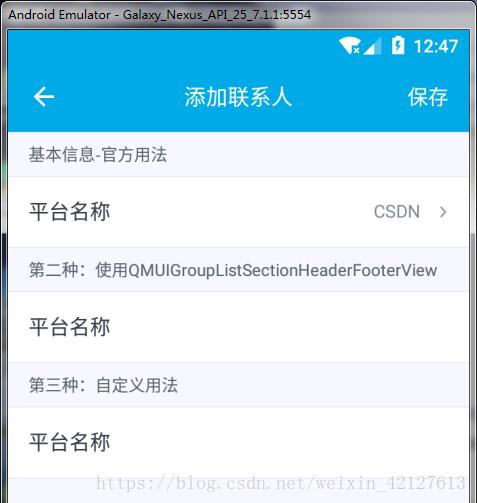上2篇文章分析了QMUIGroupListSectionHeaderFooterView的源码结构和属性样式,大概知道了它是怎么被调用的,以及设置了哪些属性样式,那么我们就可以手动的创建出跟官方一模一样的样式效果了。
那么现在就来体验吧。使用3种方式做出QMUIGroupListSectionHeaderFooterView的效果:官方QMUIGroupListView的用法,QMUIGroupListSectionHeaderFooterView的用法,和自定义TextView的用法。
1、先看看官方QMUIGroupListView的用法。
官方的用法比较简单,就是调用QMUIGroupListView的newSection方法创建一个新的section后,再调用setTitle设置标题即可。如果不设置标题,则会默认留空白间距。
整个布局文件的代码如下,只是添加了一个QMUIGroupListView。
<LinearLayout xmlns:android="http://schemas.android.com/apk/res/android"
xmlns:app="http://schemas.android.com/apk/res-auto"
xmlns:tools="http://schemas.android.com/tools"
android:layout_width="match_parent"
android:layout_height="match_parent"
android:background="?attr/app_primary_color"
android:fitsSystemWindows="true"
android:orientation="vertical"
tools:context=".GridLayoutActivity">
<com.qmuiteam.qmui.widget.QMUITopBar
android:id="@+id/topbar"
android:layout_width="match_parent"
android:layout_height="?attr/qmui_topbar_height" />
<ScrollView
android:layout_width="match_parent"
android:layout_height="match_parent"
android:background="@color/qmui_config_color_background">
<LinearLayout
android:layout_width="match_parent"
android:layout_height="wrap_content">
<!--官方QMUIGroupListView的用法-->
<com.qmuiteam.qmui.widget.grouplist.QMUIGroupListView
android:id="@+id/group_list_item_contact"
android:layout_width="match_parent"
android:layout_height="wrap_content" />
</LinearLayout>
</ScrollView>
</LinearLayout>代码部分,可以添加一个QMUICommonListItemView,用于增加显示效果。其余的就如官方演示的那样,newSection后就setTitle,然后addTo成员变量即可。
至于这个变量mGroupListContact,则在头部定义。
@BindView(R.id.group_list_item_contact)
QMUIGroupListView mGroupListContact; QMUICommonListItemView listItemName = mGroupListContact.createItemView("平台名称");
listItemName.setDetailText("优快云");
listItemName.setAccessoryType(QMUICommonListItemView.ACCESSORY_TYPE_CHEVRON);
QMUIGroupListView.newSection(this)
.setTitle("基本信息-官方用法")
.addItemView(listItemName,null)
.addTo(mGroupListContact);上面的代码,放到相应Activity的onCreate函数即可。运行后的效果图如下。

2、单独直接使用QMUIGroupListSectionHeaderFooterView的用法。
官方说了,QMUIGroupListSectionHeaderFooterView是可以单独使用的,那么我们就单独使用一下。
在布局文件中添加QMUIGroupListSectionHeaderFooterView控件,这个需要手动的添加代码。代码如下。为了对比效果,我们在后面也添加了一个TextView。
<!--官方QMUIGroupListView的用法-->
<com.qmuiteam.qmui.widget.grouplist.QMUIGroupListView
android:id="@+id/group_list_item_contact"
android:layout_width="match_parent"
android:layout_height="wrap_content" />
<!--单独直接使用QMUIGroupListSectionHeaderFooterView的用法-->
<com.qmuiteam.qmui.widget.grouplist.QMUIGroupListSectionHeaderFooterView
android:id="@+id/group_list_section_header_contact"
android:layout_width="match_parent"
android:layout_height="wrap_content" />
<TextView
android:layout_width="match_parent"
android:layout_height="@dimen/qmui_list_item_height"
android:paddingLeft="@dimen/common_content_spacing"
android:background="@drawable/qmui_s_list_item_bg_with_border_double"
android:ellipsize="end"
android:gravity="left|center_vertical"
android:includeFontPadding="false"
android:textSize="?attr/qmui_common_list_item_title_h_text_size"
android:textColor="?attr/qmui_config_color_gray_1"
android:text="平台名称"/>可以看到,布局文件里面并未做任何设置。需要在代码里面设置内容。代码方面,先定义这个的成员变量,然后只需要调用setText设置文本内容即可。
@BindView(R.id.group_list_section_header_contact)
QMUIGroupListSectionHeaderFooterView mHeaderFooterContact;在onCreate函数里面初始化。
//第二种用法,设置标题内容
mHeaderFooterContact.setText("第二种:使用QMUIGroupListSectionHeaderFooterView");最后运行,看看效果,跟第一种是一样的。

3、自定义TextView样式的用法。
自定义的用法,就是说我们不使用QMUI框架的类,用我们自己的TextView,来达到同样的效果。
创建一个TextView用作QMUIGroupListSectionHeaderFooterView,看看上篇文章中应用了哪些样式,那么我们就应用这些样式。布局文件xml的代码如下。
<!--自定义的用法。第一个TextView就是QMUIGroupListSectionHeaderFooterView-->
<TextView
android:layout_width="match_parent"
android:layout_height="wrap_content"
android:textSize="@dimen/qmui_group_list_section_header_footer_text_size"
android:textColor="?attr/qmui_config_color_gray_3"
android:gravity="left"
android:paddingLeft="?attr/qmui_content_padding_horizontal"
android:paddingRight="?attr/qmui_content_padding_horizontal"
android:paddingTop="@dimen/qmui_group_list_section_header_footer_padding_vertical"
android:paddingBottom="@dimen/qmui_group_list_section_header_footer_padding_vertical"
android:text="第三种:自定义用法"/>
<TextView
android:layout_width="match_parent"
android:layout_height="@dimen/qmui_list_item_height"
android:paddingLeft="@dimen/common_content_spacing"
android:background="@drawable/qmui_s_list_item_bg_with_border_double"
android:ellipsize="end"
android:gravity="left|center_vertical"
android:includeFontPadding="false"
android:textSize="?attr/qmui_common_list_item_title_h_text_size"
android:textColor="?attr/qmui_config_color_gray_1"
android:text="平台名称"/>至于代码部分,则不需要代码。直接在layout布局文件中设置样式即可。最后运行的效果如下,跟上两种的效果一样。

最后总结:3种方法各有各的用处,灵活运用,就可以使用不同的场景,并且可以自己改造。





 本文介绍三种实现QMUIGroupListSectionHeaderFooterView样式的方法:官方QMUIGroupListView用法、直接使用QMUIGroupListSectionHeaderFooterView及自定义TextView样式。通过实例代码展示了每种方法的具体步骤及最终效果。
本文介绍三种实现QMUIGroupListSectionHeaderFooterView样式的方法:官方QMUIGroupListView用法、直接使用QMUIGroupListSectionHeaderFooterView及自定义TextView样式。通过实例代码展示了每种方法的具体步骤及最终效果。
















 2129
2129

 被折叠的 条评论
为什么被折叠?
被折叠的 条评论
为什么被折叠?








